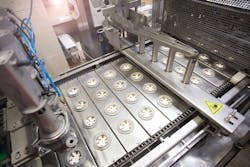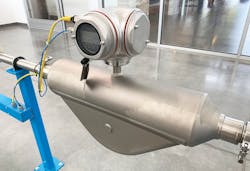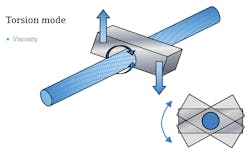Using flowmeter measurements to improve quality
Depending on the product under scrutiny, food and beverage plant managers may have to meet the requirements of the Food & Drug Administration (FDA), European Union (EU) and other agencies. Applicable regulations may include cGMP, GFSI, ISO, HACCP, SQF, SID and others.
These requirements and regulations specify proper ingredients, procedures and sanitary conditions. In many cases, compliance with these regulations requires lab analyses during and after production.
To perform a lab test (Figure 1), technicians periodically take a grab sample, take it to an on-site facility for analysis and communicate the result to plant personnel. Operators and maintenance personnel then make adjustments and corrections to improve control of the process, or make repairs when required.
This presents problems because lab analyses aren’t done in real time, are time-consuming, are labor intensive and raise the possibility for manual errors. Even if it takes at least 30 minutes to grab a sample, analyze it and report the results — this information represents where the process was 30 minutes ago — not now. The result could be a spoiled batch.
If the measurement had been done inline, a sudden deviation would be detected. Inline measurements can also be used to enable automatic closed-loop control, which is not possible with manual measurements. A typical closed-loop control strategy uses an inline measurement as the process variable input to a proportional-integral-derivative (PID) controller. The controller output drives some type of a regulating device, such as a control valve. The PID controller continually and automatically adjusts its output to maintain the desired value close to the setpoint.
Often overlooked by many in the industry is the ability of Coriolis flowmeters to be used for quality control. This article shows how Coriolis flowmeters can be used in the food industry to monitor processes and reduce or eliminate the need for lab analyses.
Testing required
Checking for product purity and quality is important, but so is meeting the expectations of consumers for proper taste and texture.
For example, cold and hot wort measurements in a brewery are important to ensure best quality and yield, as well as taste.
Viscosity measurements can test for consistency of the batter coating for beans, onions, meat and poultry. Measuring the Brix of tomato paste can help control the amount of paste to be added during cutting.
A single Coriolis flowmeter (Figure 2) can measure a number of parameters simultaneously, including density, concentration, viscosity, Brix, Plato, volume, mass flow and temperature — often eliminating the need for multiple instruments.
For example, the flowmeter’s highly accurate density funct function can be used to measure Brix and Plato values to ensure the quality of ingredients. Viscosity readings provide continuous measurement to minimize the chance of producing off-spec product.
Diagnostics built into a Coriolis flowmeter can help identify process problems. For example, entrained air in a line can affect product quality. An operator needs to know if external air is being drawn in through a leaking seal, a cavitating pump or an empty balance tank.
A Coriolis flowmeter does not operate properly with large amounts of entrained air, so it has diagnostics to detect this condition. In an Endress+Hauser Coriolis meter, a diagnostic value shows that tube oscillation is in a good range, indicating no entrained air. If air appears in the line, the diagnostic value will change (Figure 3), setting off an alarm to the operator.
A Coriolis mass flowmeter measures the density and flow rate of fluids simultaneously as they flow through its tubes (Figure 4). These devices are based in principle on the Coriolis Effect, which is the deflection of the path of a fluid within its tubes. An excitation coil oscillates the tubes at the first node of their resonance frequency, and the frequency of oscillation changes with the density of the fluid.
Initially, when there is no flow, the tubes oscillate synchronously. But as fluid begins to flow, the sensors on the inlet and outlet bends begin to oscillate non-synchronously with a phase shift. Measuring the oscillation frequency provides data to determine flow, mass flow, density, concentration, etc.
The flowmeter has resistance temperature detectors (RTDs) installed to measure the temperature of the fluid. RTDs also measure the temperature of the tubes, which is required because tube elasticity changes with temperature. The changes in elasticity will impact how the tubes bend and therefore the density measurement, so temperature compensation factors are needed for density calculation.
The applications described below cover measuring concentration, viscosity and density, but these are only some of the possible on-line quality measurements possible with Coriolis flowmeters.
Checking concentration makes beer better
Concentration measurements are made by breweries, which need to control the sugar content of their wort to determine the alcoholic strength of the beer. The amount of sugar content correlates to degrees Plato (°P); for example, 1°P wort will contain 1 gram of sugar per 100 grams of wort.
A Coriolis flowmeter provides an accurate density and temperature measurement, both of which are needed to determine the degrees Plato. A Coriolis flowmeter also has integrated formulas that use the measured density and temperature to calculate concentration.
In a brewery, after the grains are malted and milled, the mash goes into a lauter tun, a vessel used to separate mash from the wort. Density and concentration measurements are made as the wort leaves the lauter tun.
There are multiple methods1 to measure sugar content, both manual and automated. However, the manual measurement is usually taken after the lautering process is complete, whereas an inline measurement allows for real-time correction of the process, often by automated means via closed-loop control. The end result is reduced waste from bad batches, and reduced time and labor by not having to manually sample the wort.
Validating viscosity
Fruit processing plants need a history of raw fruit temperature, density, Brix, viscosity, flow rate and total flow volume.
A Coriolis flowmeter measures density, so it can calculate Brix, proportional to the amount of sucrose content in water. This measurement provides a picture of the condition and quality of incoming fruit. For example, hard fruit that is still in solid chunks will show a low Brix. In contrast, a high Brix measurement could indicate overripe, mushy fruit with very little intact solids. Operators or the control system can use the Brix measurement to determine how to process the incoming fruit.
Viscosity of the fruit product is measured to determine end-product quality. Viscosity describes the flowing properties of a fluid, and it depends on the forces acting between molecules. The more viscous a fluid is, the stronger the intermolecular forces. As a result, larger internal resistance has to be overcome to move the fluid or apply a force to it. Viscosity is an indirect measurement of product consistency and quality.
A Coriolis flowmeter can use two simultaneously driven frequencies for measuring mass flow and viscosity. The torsional or viscosity mode uses a higher frequency to induce a shear rate on the fluid (Figure 5) with the shear force on the inside of the tube being a function of shear rate and viscosity. By measuring the drive current, viscosity can be calculated.
In new Coriolis flowmeters, two eigenmodes are stimulated by an exciter on the measuring tube: the bending mode and the torsion mode. The bending mode determines fluid density and mass flow, while viscosity is calculated based on the torsion mode.
Viscosity is usually measured in a lab, under lab conditions. The advantage of measuring viscosity directly in the process is that it’s a true reflection of the process conditions and avoids the delay of taking samples to the lab. This allows for live corrections of the process if viscosity is outside the product’s tolerances, often by automated means.
Ice cream overrun
Food products are often foamed with gases to achieve the desired consistency. This occurs, for example, when ice cream is produced. Gas is injected during the freezing process, trapping microbubbles into the ice cream to give it a creamy texture. This process works with high-fat as well as low-fat ice cream.
Gas content is a significant factor in the overall quality of the final product and is an important process parameter. The increase in volume of the final product caused by the injected gas is known as overrun. Depending on the product, the overrun can be between 20% and 120% for ice cream or frozen products.
A Coriolis flowmeter can be used to make this measurement. For example, the Endress+Hauser Promass Q with Multi-Frequency Technology enables continuous monitoring of the overrun. The density of the liquid ice cream is measured as it’s being transferred to the freezers.
Ice cream plants typically inject air, manually measure density and adjust the process accordingly. Air injection needs to be adjusted if the recipe, freezer temperature or air pressure changes. A Coriolis flowmeter provides the measurement online2, saving sampling time and allowing immediate and automatic adjustment of air injection.
Adding instrumentation
This article only covers how Coriolis flowmeters can be used for inline quality monitoring in food plants. While Coriolis flowmeters are extremely capable, adding additional instruments — such as pH meters, colorimeters, dissolved oxygen sensors and other in-line analysis devices — can help a food plant analyze and control even more of its processes in real time.
References
- “Inline Gravity Measurement,” Brewer and Distiller International April 2016
- Promass Q: Overrun measurement
Adam Booth is the Flow Product Marketing Manager for Endress+Hauser. He graduated from Purdue University in 2016 with a degree in Mechanical Engineering Technology. After graduation he joined Endress+Hauser’s Rotational Engineering Development Program in 2016. Prior to his current role, Booth was a Technical Support Engineer for Endress+Hauser. While in those roles, he developed expertise with Endress+Hauser’s Flow portfolio and gained hands-on experience in the field.







